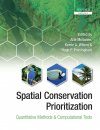About this book
Habitat loss and deterioration, climate change, and economic pressures for resource extraction have all led to a global loss of biodiversity. The limited resources available for conservation need to be used both effectively and efficiently in order to minimise further losses.
Spatial conservation prioritization addresses the question of how we should allocate conservation effort and funds in space and time. While the benefits of quantitative conservation prioritization methods have been widely promoted, adoption of these methods in "real-world" planning and implementation is still in its infancy, partly due to the difficulty of identifying which methods and tools (if any) are suited to specific planning problems.
Spatial Conservation Prioritization brings together a team of leading scientists to introduce the conceptual and methodological aspects of how to undertake spatial conservation planning in a quantitative manner. It provides the reader with information on when, why, and how to use which statistical and computational methods for conservation prioritization. Important topics underlying spatial prioritization including metapopulation modelling, population viability analysis modelling, species distribution modelling, and uncertainty analysis are discussed, as well as operational definitions and methods. The book includes chapters on the most widely used and latest software, and concludes with an insight into the future of the field.
Contents
Preface
1. Quantitative Approaches to Spatial Conservation Prioritization: Matching the Solution to the Need , Simon Ferrier & Brendan A. Wintle
2. Fundamental Concepts of Spatial Conservation Prioritization , Kerrie A. Wilson, Mar Cabeza & Carissa J. Klein
3. A Mathematical Classification of Conservation Prioritization Problems , Atte Moilanen, Hugh P. Possingham & Stephen Polasky
4. Integer Programming Methods for Reserve Selection and Design , Robert G. Haight & Stephanie A. Snyder
5. Heuristic and Approximate Optimization Methods for Spatial Conservation Prioritization , Atte Moilanen & Ian Ball
6. Conservation Prioritization Using Species Distribution Modelling , Jane Elith & John Leathwick
7. Community-level Approaches to Spatial Conservation Prioritization , Simon Ferrier, Daniel P. Faith, Anni Arponen, & Michael Drielsma
8. Conservation Prioritization Using Metapopulation Models , Emily Nicholson & Otso Ovaskainen
9. Spatial Population Viability Analysis , Michael A. McCarthy
10. Accounting for Habitat Dynamics in Conservation Planning , Hugh P. Possingham, Atte Moilanen & Kerrie A. Wilson
11. Conservation Prioritization and Uncertainty in Planning Inputs , Helen M. Regan, Michelle Ensbey & Mark A. Burgman
12. Prioritizing Ecosystems, Species, and Sites for Restoration , Reed Noss, Scott Nielsen & Ken Vance-Borland
13. Climate Change and Spatial Conservation Planning , Miguel B. Arajo
14. Marxan and Relatives: Software for Spatial Conservation Prioritization , Ian R. Ball, Hugh P. Possingham & Matthew E. Watts
15. The Zonation Framework and Software for Conservation Prioritization , Atte Moilanen, Heini Kujala & John R. Leathwick
16. The C-Plan Conservation Planning System: Origins, Applications and Possible Futures , Robert L. Pressey, Matthew E. Watts, Thomas W. Barrett & Malcolm J. Ridges
17. The ConsNet Software Platform for Systematic Conservation Planning , Sahotra Sarkar, Trevon Fuller, Anshu Aggarwal, Alexander Moffett & Christopher D. Kelley
18. From Theory to Practice: Designing and Situating Spatial Prioritization Approaches to Better Implement Conservation Action , Andrew T. Knight, Richard M. Cowling, Hugh P. Possingham & Kerrie A. Wilson 19. Spatial Conservation Prioritization: Past, Present, and Future , Atte Moilanen, Hugh P. Possingham & Kerrie A. Wilson
References
Index
Customer Reviews
Biography
Edited by Atte Moilanen, Department of Biological and Environmental Sciences, University of Helsinki, Finland, Kerrie A. Wilson, School of Integrative Biology, The University of Queensland, Australia, and Hugh Possingham, The Ecology Centre and Department of Mathematics, The University of Queensland, Australia



































